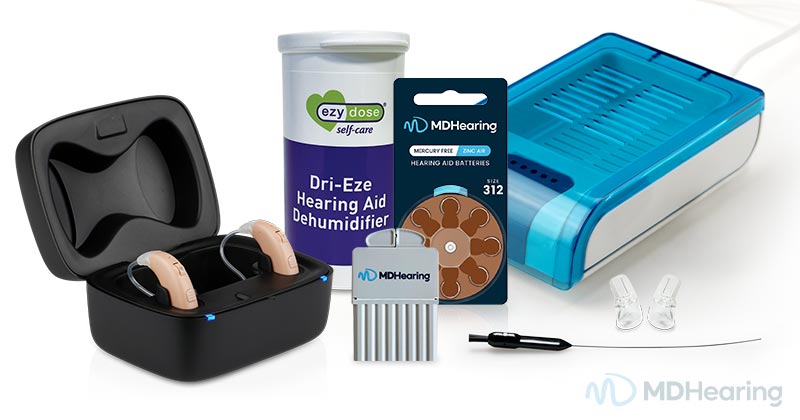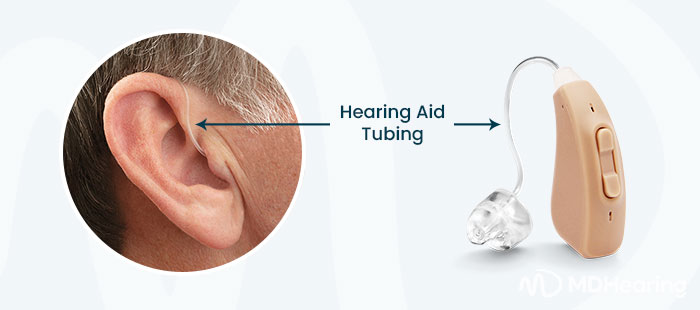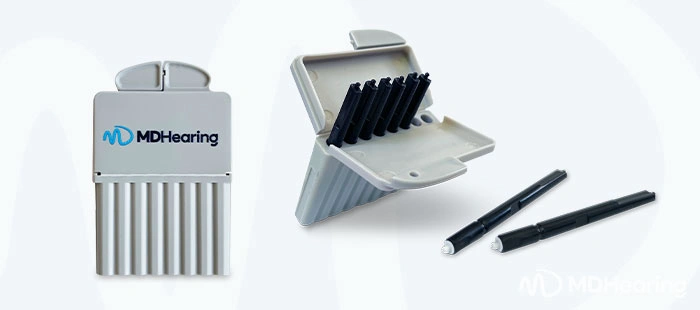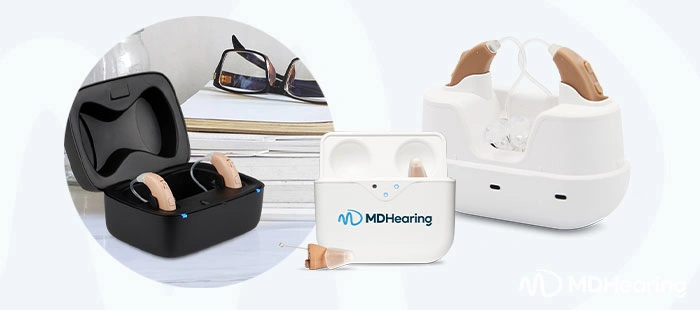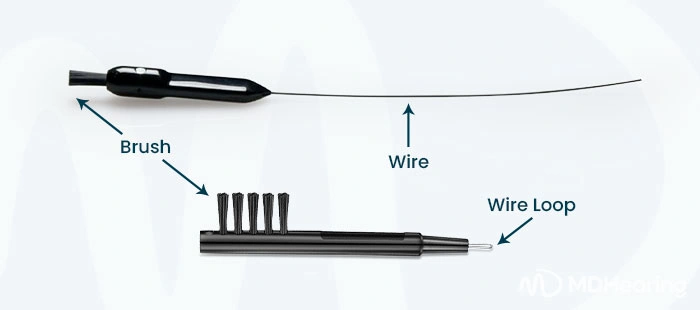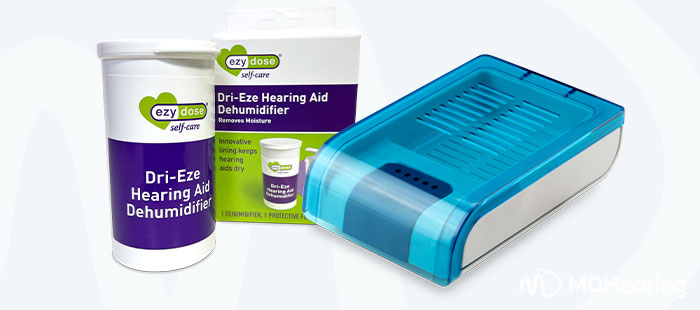Whether you're a seasoned wearer or new to the world of hearing aids, understanding the importance of proper maintenance and having the right supplies is crucial. These small devices play a significant role in enhancing our daily lives by improving our ability to communicate and connect with the world around us.
In this blog, we'll delve into the essential supplies needed to keep your hearing aids in optimal condition and avoid costly repairs. From cleaning tools to replacement parts, each component plays a vital role in ensuring that your device functions effectively and reliably for many years.
Here is a list of the most common hearing aid supplies for optimal listening experiences.
Hearing Aid Tips, Domes, and Earmolds
Hearing aid tips and domes are silicone pieces that attach to the end of an ITE (in-the-ear) hearing aid or the tubing of BTE (behind-the-ear) and RIC (receiver-in-canal) hearing aids. These tips fit inside your ear canal and are typically shaped like a funnel, dome, or mushroom. They’re designed to be one-size-fits-most and are an affordable alternative to a customized ear mold.
-
Open Domes – Open domes contain several holes to allow airflow and natural sounds (like your own voice) to be heard. This type of dome helps reduce what's called "the occlusion effect," which makes sounds hollow. Open domes are most suited for people with high-frequency hearing loss.
-
Closed Domes – Closed domes have only one small hole and are mostly closed to block out external sounds. They're often recommended when hearing loss is moderate to severe.
-
Power Domes – Power domes are the most occlusive domes. This type of dome is used for people with moderate to severe hearing loss.
-
Earmold – An earmold is custom-fitted to the shape of your ear. They serve the same purpose as tips and domes, but with a more custom fit and added cost. Some earmolds have an extra hole used for venting out moisture and improving the sound quality.
- Hard Earmolds – hard, custom earpieces made of plastic or acrylic
-
Soft Earmolds – soft, flexible custom earpieces made of silicone or other soft materials
MDHearing’s BTE hearing aids use ComfortTIPs™, which are curved tips ergonomically designed to follow the shape of your ear canal. If you’d like an alternative to the ComfortTIPs, our BTE hearing aids can also be fitted with an open dome, closed dome, or double bass domes. MDHearing’s ITE hearing aids use oval domes or bell domes depending on the hearing aid model.
Maintenance Tip: Domes and tips are easy to clean but should be replaced every couple of months due to deterioration caused by moisture and earwax.
Hearing Aid Tubing
Hearing aid tubes are used with BTE hearing aids to transfer the sound from the hearing aid into your ear canal. Tubing is commonly made from discreet, clear silicone and comes in different sizes, shapes, and lengths to fit a large variety of ear shapes. Check your hearing aid user manual to find out what tubing your hearing aid is compatible with.
MDHearing’s BTE hearing aids come assembled with 2B (standard) length tubing, and are also compatible with 1B (shorter) and 3B (longer) tubing. The only exception is our MDHearing VOLT, which is not compatible with 1B tubing.
Maintenance Tip: Tubing is easy to clean and should be changed every three to six months, or whenever it becomes discolored or loses its shape.
Hearing Aid Wax Guards
In-ear hearing aids and RIC hearing aids utilize wax guards (also known as wax traps or wax filters) on the tip of the hearing aid to prevent wax, moisture, and debris from entering the hearing aid and causing it to malfunction. You can think of wax guards like a bucket collecting earwax that otherwise would have gone into your hearing aid receiver (where the sound comes out of).
How often you need to change the wax guards is determined by the amount of wax your ear produces. The wax guards have small holes that can get plugged up and cause the sound to be weakened, indicating that it's time to change them. Some people need to change theirs every couple of weeks, while others can go for a few months. Check your hearing aid user manual on how to change the wax guards because they can vary in design and usually require a unique tool to remove and insert.
Maintenance Tip: Keeping your ears free of wax by using an earwax removal system can help reduce the frequency of replacing wax guards and other hearing aid parts.
Hearing Aid Batteries and Chargers
Hearing aids can be powered one of two ways: disposable zinc-air batteries or rechargeable lithium-ion batteries.
Disposable Hearing Aid Batteries
Disposable hearing aid batteries are available in four main sizes; typically the larger the battery, the longer it lasts—which can be anywhere from a few days to a few weeks. The duration will depend on the type of battery, frequency hearing aids are worn, and use of advanced features.
-
Size 675 Batteries (blue tab) – lasts 9-21 days
-
Size 13 Batteries (orange tab) – lasts 6-21 days
-
Size 312 Batteries (brown tab) – lasts 5-12 days
-
Size 10 Batteries (yellow tab) – lasts 4-6 days
Maintenance Tip: After removing the protective tab, be sure to wait at least one minute before inserting the battery so that it has time to activate and lasts longer. Additionally, open the battery door when your hearing aids are not in use in order to help your batteries last longer.
Rechargeable Hearing Aids
Rechargeable hearing aid batteries have become much more common as technology has evolved, eliminating the need for traditional disposable batteries. Rechargeable hearing aids are equipped with built-in lithium-ion batteries that can be conveniently charged overnight using a charging dock or case. This is especially beneficial for individuals with dexterity issues, as they no longer need to handle and replace small disposable batteries.
Rechargeable hearing aids not only reduce waste from disposable batteries, but also offer greater convenience and cost savings over time.
Rechargeable hearing aids typically provide a full day of use on a single charge. Some charging cases also store extra power, providing additional charges on the go without needing to be plugged in.
All of MDHearing’s hearing aids are now rechargeable. The model of charging case depends on which hearing aid you have.
Maintenance Tip: We recommend wiping the hearing aid with a dry, soft cloth to remove any moisture or oils before placing it in the charging case.
Hearing Aid Cleaning Tools
To get the most out of your hearing aids, it’s essential to regularly clean your hearing aids. There are several different cleaning supplies to keep your hearing aid performing at its best.
-
Wire/Wax Loop and Brush – Most hearing aids come with a cleaning tool that has two ends: one with a small brush and one with a wax remover loop or wire designed to remove earwax that often builds up. When the tubing, tip, dome, or earmold is clogged, it affects the quality of sound. The brush end can also be used to clean the microphone(s) gently.
-
Cleaning Sprays and Wipes – You can buy sprays or wipes made to clean and deodorize parts of your hearing aids. Some of these cleaners contain a disinfectant that effectively kills harmful bacteria, viruses, and fungi that may be found on the earpieces.
-
Hearing Aid Air Blower – If you often sweat or get the area around your hearing aid wet, moisture can block the opening in your tips and tubing. When build-up prevents you from hearing correctly, sometimes it's better to use an air blower. A tubing air blower works by forcing condensation and debris out of the hearing aid.
Maintenance Tip: Do not use water or alcohol to clean your hearing aid because they can damage the electronic components. Instead, use a microfiber cloth to wipe away contaminants.
Hearing Aid Dehumidifiers and Sanitizers
Moisture can build up in all areas of your hearing aid, especially if you live in a humid climate. When water collects, it can block the sound from getting through to your ear. Moisture exposure will also damage the electronic components and battery compartment, causing corrosion and rust over time. There are several products designed to get rid of moisture in your hearing aids.
-
Dehumidifier Jar – Non-electric or battery-powered drying cups contain a desiccant substance designed to absorb sweat, condensation, and other types of moisture. The desiccant can be in various forms, including linings, discs, and beads.
-
UV-Clean and Dry Box – Electric dehumidifiers use heat to eliminate moisture and ultraviolet (UV) light to kill bacteria, viruses, and other harmful germs. Unlike regular hearing aid dryers, UV cleaners sanitize your hearing aids.
Maintenance Tip: Dehumidifiers last for six months to two years, so you can store your hearing aids in a dehumidifier overnight rather than in your regular carrying case.
Hearing Aid Microphone, Amplifier, and Receiver
In most hearing aids, the microphone, amplifier, and receiver (also known as the speaker) are located inside the body of the hearing aid. These components are usually not replaceable, but will last for years as long as they are kept clean and free of moisture. The exception being RIC hearing aids, in which the receiver sits in your ear canal and must be replaced regularly.
Maintenance Tip: If you notice any cracks, broken parts, or exposed wires on the body of your hearing aid, contact the company you purchased your hearing aids from to repair or replace the damage.
Conclusion
Maintaining your hearing aids is essential for ensuring their longevity and optimal performance. Your hearing aids have several vital components that make them effective at helping you hear better, and when moisture, ear wax, and debris build up, it can prevent you from getting the crisp, clear sound you depend on. With the many hearing aid supplies, cleaning tools, and dehumidifiers available, regular maintenance becomes an easy enough task.
By regularly cleaning and replacing supplies—such as tubing, tips, domes, wax guards, and batteries—you can significantly enhance your hearing experience and avoid potential issues.
There are many top hearing aid brands on the market, but MDHearing offers doctor-designed and FDA-registered OTC devices along with all the hearing aid supplies you need. When you buy from us, you have the option of getting extra coverage with the MDShield Protection Plan. If you or a loved one have trouble hearing, you can take our free online hearing test for immediate results.
Looking for MDHearing supplies and accessories?
BROWSE HEARING AID SUPPLIES
